Shintaido Kenjutsu Q & R avec Master H.F.Ito.
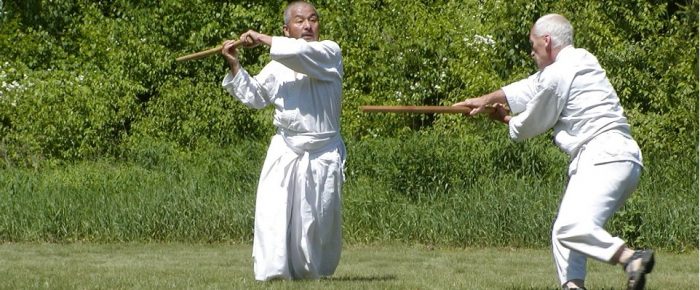
Interview par Sarah Baker – Janvier 2020
Qu’est-ce que Shintaido Kenjutsu?
Shintaido signifie « Nouvelle Voie du Corps », nous pourrions aussi l’appeler un art ou nouveaux mouvementx d’expression de la vie. Lorsque les gens entendent Shintaido, la syllabe à la fin est Do, qui est généralement utilisée pour les arts martiaux. Mais Shintaido est plus qu’un art martial. C’est un mouvement pour le développement du potentiel humain.
Quelle est la différence entre le Kendo et le Kenjutsu (Judo et Jujutsu)?
Kenjutsu signifie techniques de combat au sabre. Donc, Shintaido Kenjutsu représente l’expression de votre vie à travers des techniques du sabre. Durant la période des samouraïs au Japon, personne n’utilisait le mot kendo (ou judo d’ailleurs). Les termes étaient kenjutsu et jujutsu, et ils faisaient référence à des techniques de combat. Les mots Kendo et Judo sont entrés en vigueur lorsque le Japon a commencé à se moderniser, après la restauration de Meiji vers 1865. Cela a marqué la fin du style de vie des samouraïs. Les gens n’étaient plus autorisés à prendre actes des questions de loi et d’ordre, à se venger de leurs propres chef ; ces affaires étaient désormais traitées par la police et les tribunaux. Les techniques du sabre et les arts martiaux étaient encore pratiqués, mais plutôt comme une forme de sport ou d’entraînement physique, pratiqués dans des espaces semblables à un gymnase. C’est à ce moment que les termes kendo et judo sont devenus populaires
Kendo signifie littéralement « la voie du sabre » et Judo signifie littéralement « la voie de la flexibilité ». Bien que ces mots sonnent bien et que la pratique soit censée conduire à l’illumination, ce type de keiko peut en fait devenir creux et inflexible lorsqu’il s’éloigne des exigences du champ de bataille. À sa base, le Shintaido est conçu pour nous faire vivre des interactions de vie et de mort sans avoir à s’entretuer.
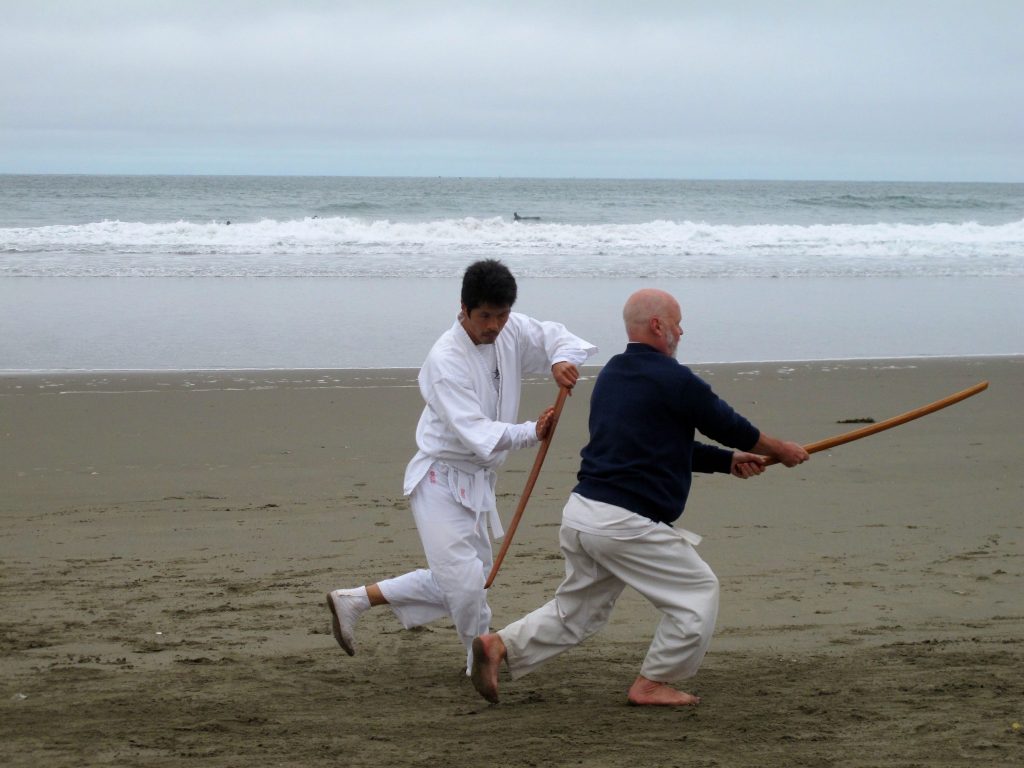
Quelle est la différence entre le karate et le kenjutsu de votre point de vue culturel ?
Le karaté est venu d’Okinawa, et en conséquence, il comprenait beaucoup d’influences d’arts martiaux chinois parce qu’Okinawa a été occupée par la Chine et le Japon et à différentes époques de l’histoire. Le Kenjutsu est totalement japonais et est affecté par ce que nous appelons la «culture insulaire» du Japon, ce qui signifie qu’il a été relativement isolé et peu influencé par d’autres formes d’art martial. De plus, le Kenjutsu a des liens étroits avec le Zen, qui est la forme du bouddhisme suivie par de nombreux samouraïs japonais.
Le karaté a de façon caractéristique développé les katas, pratiqués individuellement. Le kihon est pratiqué à l’unisson avec un groupe, et le kumite, pratiqué avec un partenaire. Traditionnellement en Kenjutsu, Kihon et Kata sont pratiqués individuellement, et non pas à l’unisson.
Parce que le karaté a des exercices de groupe, Maître Aoki a pu développer le Goreijutsu, des techniques pour exécuter le gorei. C’est l’un des points forts du Karaté, de par son influence chinoise.
Le karaté est une relation horizontale, c’est très pratique pour le combat traditionnel. Les instructeurs ne sont pas responsables du développement spirituel de leurs élèves. Le Kenjutsu a une grande composante verticale – intellect-corps-esprit – l’instructeur a la responsabilité de développer ces trois aspects chez ses élèves.
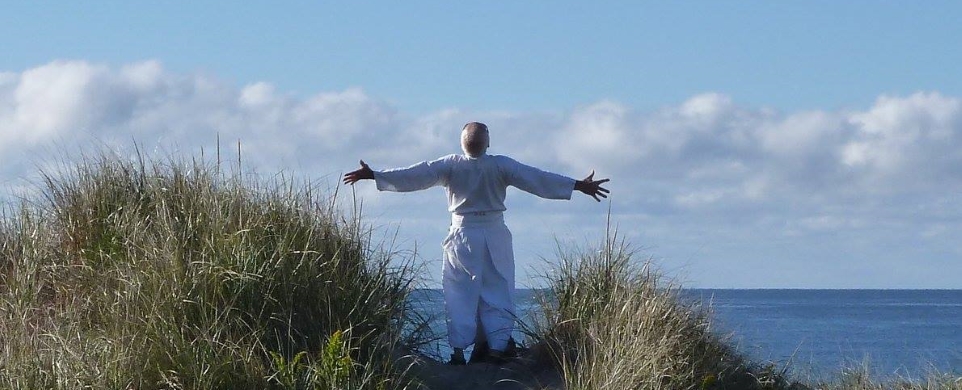
D’où vient Kyu-Ka-Jo Kumitachi?
Dans Shintaido : un nouvel art du mouvement et de l’expression de la vie (1982), Maître Aoki a déclaré que Kyu-Ka-Jo Kumitachi venait de Maître Inoue Hoken, qui était le fondateur de Shinwa Taido. J’ai entendu une rumeur selon laquelle Maître Inoue était de la lignée d’Itto Ryu Kenjutsu, et Maître Ueshiba était de la lignée de Shinkage Ryu Kenjutsu. Je crois que Kyu-Ka-Jo Kumitachi est issu de la tradition Itto Ryu. Cela signifie que les pratiquants de Shintaido ont de la chance, parce que nous avons accès, via notre keiko, à la pratique traditionnelle Itto Ryu.
Qu’est-ce que Jissen Kumitachi ?
Le concept original de Jissen Kumitachi est venu d’une équipe / projet composée de Maître Okada, Maître Minagawa et moi. Kyu-Ka-Jo Kumitachi est un excellent véhicule de développement spirituel et d’harmonisation corps-esprit, mais ce n’est pas nécessairement très pratique en termes de technique de sabre. À ce moment-là, j’avais étudié le Shin Kendo avec Master Obata à Los Angeles et, en raison de son expérience en Aïkido, je portais beaucoup d’influence du Shinkage Ryu. Nous avons donc pu partager tous les trois des points forts de Shinkage Ryu dans notre travail avec Jissen Kumitachi. Le mot jissen peut s’écrire de deux manières différentes en japonais: 実 戦 et 実 践. La prononciation est la même, mais la première signifie «pour les combats pratiques» et la seconde signifie «pour la vie pratique». Nous avons pu intégrer la sagesse mixte de Shinkage Ryu et Itto Ryu dans Jissen Kumitachi.
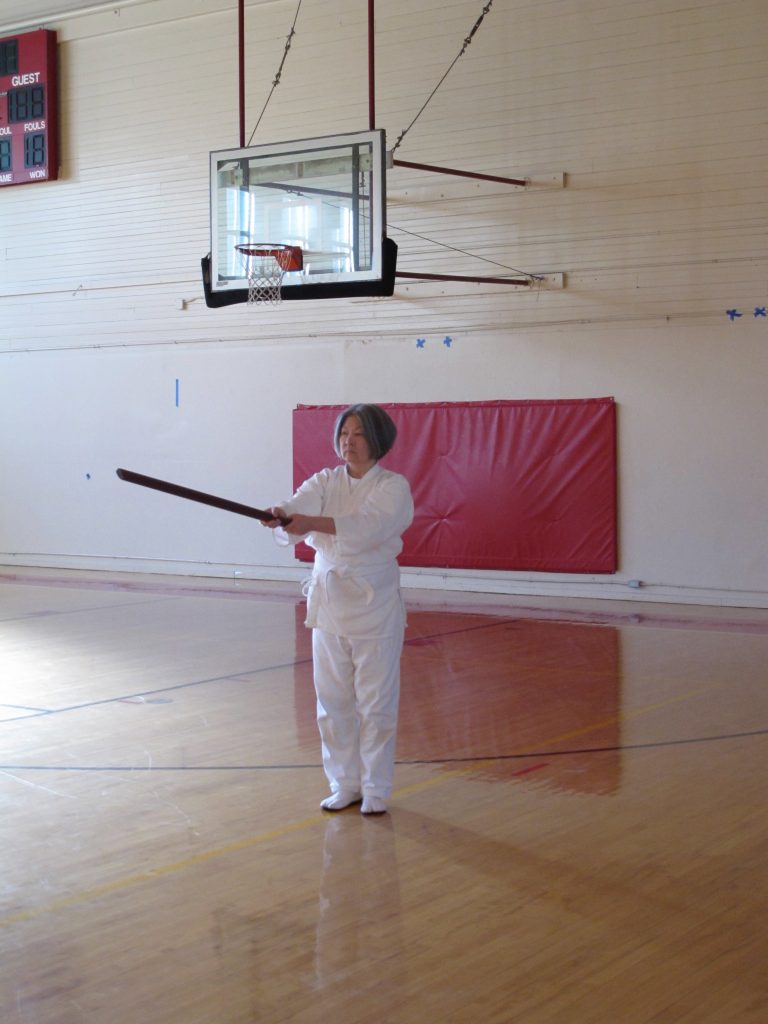
Quelle est la différence entre Bokuto et Bokken ?
Dans le monde des arts martiaux, les termes bokuto 木刀 et le bokken 木 剣 disent la même chose. Les deux signifient « épée en bois ». Mais en Shintaido, nous faisons une distinction: le bokuto est une épée droite en bois et le bokken est courbé. Nous recommandons d’utiliser un bokuto lorsque vous pratiquez le Kyu-Ka-Jo Kumitachi et d’utiliser un bokken pour Jissen Kumitachi.
Plus précisément, la pratique originale et formelle du bokuto a été conçue par Maître Aoki. Il croit que la forme de bokuto peut naturellement aider les pratiquants à ressentir l’énergie verticale Ten-Chi-Jin lorsqu’ils font Tenso. Le Shintaido Kenjutsu (par exemple Kyu-Ka-Jo Kumitachi) est censé être pratiqué avec un bokuto (épée droite en bois).
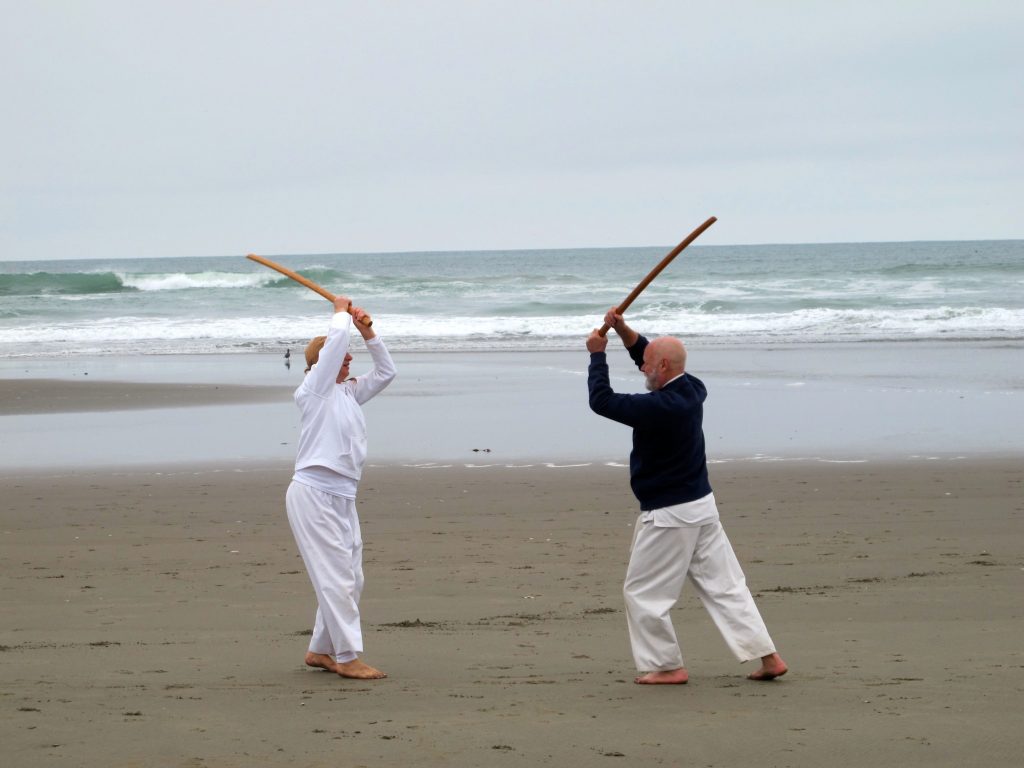
Le Shintaido Kenjutsu (par exemple Jissen Kumitachi) est censé être pratiqué avec le bokken (épée en bois incurvée). Et dans les deux cas, il est très important d’étudier et d’expérimenter les techniques et la philosophie de Tenso et Shoko lorsque vous êtes un débutant Shintaido.
Quelle est la différence entre Kirikomi and Kiriharai ?
Voir Hiroyuki Aoki, Shintaido : un nouvel art du mouvement et de l’expression de la vie (1982), p 46-47 et p 70-73.
Qu’est-ce que le Toitsu Kihon ?
Voir Hiroyuki Aoki, Shintaido : un nouvel art du mouvement et de l’expression de la vie (1982), p 88-89.
Quelle est la relation entre Maître Egami, Maître Inoue, Maître Funakoshi et Maître Aoki?
Voir le parchemin de Tomi Nagai-Rothe sur notre héritage de trois maîtres, créé dans les années 1990.
Quel est votre aperçu de l’histoire de Shintaido en tant que courant de conscience ?
Karaté Shotokai ~ Karaté Egami ~ Karaté Rakutenkai ~ Découverte de Kaisho-Ken ~ Shintaido (Toitsu-kihon) ~ Découverte de Tenshingoso & Eiko ~ Sogo-Budo ~ Shintaido-Bojutsu / Karaté ~ Yoki-Kei Shintaido ~ Shintaido comme potentiel humain en mouvement.
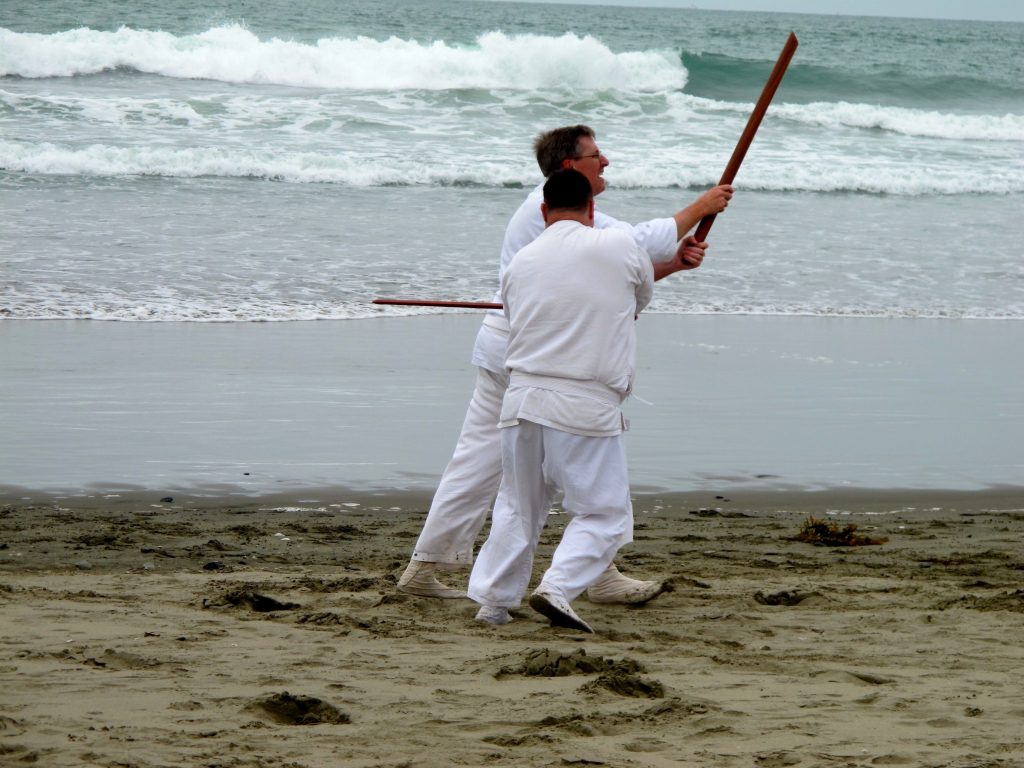
Qu’est-ce que Shintaido Kenjutsu pour vous ?
Le travail d’une vie, la conclusion de ma formation continuelle en Shintaido, un cristal / reflection de Kaiho-Kei Shintaido, Yoki-Kei Shintaido, Shintaido Bojutsu et Shintaido Karate.
Quelle est votre recommandation à ceux qui veulent commencer à étudier le Shintaido Kenjutsu ?
Si vous êtes un débutant, vous devez d’abord étudier le Shintaido Daikihon : en particulier, Tenshingoso, Eiko et Hikari / Wakame (étape 1). Après cela, Toitsu Kumite utilise le kaishoken (étape 2). Ensuite, vous pouvez démarrer Kyukajo Kumitachi (étape 3), puis Jissen Kumitachi (étape 4).
Si vous avez déjà de l’expérience avec un autre art martial, en particulier lié au Kenjutsu, vous pouvez sauter à Jissen Kumitachi (étape 4), et si vous aimez, vous pouvez ensuite étudier Kyukajo Kumitachi aussi. Et si vous voulez vraiment comprendre la discipline en profondeur, vous finirez également par étudier le Daikihon (étapes 1 et 2).
Appendix
Avez-vous étudié d’autres art martiaux en parallèle du Shintaido?
Je n’ai jamais rejoint ou appartenu à aucun autre dojo d’arts martiaux, mais j’ai fait six mois de formation au Aikido Headquarters (siège principal) au Japon en 1970. C’était juste après que Maître Aoki ait terminé le Daikihon, et juste après le décès de Maître Ueshiba. Maître Aoki était prêt à sortir du « monde Egami » et il m’a envoyé au siège de l’Aikido pour voir à quel point ce qu’il m’avait enseigné était vraiment pratique, et aussi pour comprendre quel était l’héritage de Maître Ueshiba – ses points clés secrets (en japonais, nous disons: « Découvrir ce qui est écrit sur sa pierre tombale »). Maître Aoki ne m’a pas dit combien de temps j’y serais, alors j’ai supposé que ça pourrait durer un an ou plus. Chaque soir, je rentrais à la maison et il me demandait ce que j’avais étudié. Je m’intéressais de plus en plus à l’Aïkido et j’étais entouré de gens qui avaient étudié avec Maître Ueshiba, même si je ne l’avais jamais rencontré moi-même. J’étais vraiment flexible à cause de tous mes keiko durs à ce moment-là, donc leurs clefs de bras ou poignets ne fonctionnaient pas sur moi (je ne leur ai pas dit, bien sûr, j’étais respectueux), et mon tsuki était vraiment solide, donc Je savais que je pouvais les frapper à tout moment (mais je ne l’ai pas fait bien sûr, j’étais respectueux). Je travaillais avec un homme plus âgé, pas un instructeur, et je l’attaquais doucement, mais une fois que je l’ai attaqué fortement sans avertissement, et soudain je me suis retrouvé par terre ! Après cela, je suis devenu beaucoup plus respectueux envers l’Aikido. Quand j’ai raconté cette histoire à Maître Aoki, il a dit: “D’accord, vous n’avez plus besoin d’y aller.” Je pense que Maître Aoki collectionnait des techniques d’Aikido à travers moi, mais il a probablement reconnu que j’étais devenu plutôt fier de moi, alors il m’a probablement envoyé au dojo d’Aikido pour apprendre un peu d’humilité et de respect envers les autres arts martiaux.
Peu de temps après, j’ai été nommé Doshu (Maître Instructeur) en 1988 à Tanzawa, au Japon. Maître Aoki disait que puisque j’étais Maître Instructeur, je devais aller étudier le Tameshigiri (techniques de coupe réelles) auprès de Maître Toshishiro Obata. Il avait été le champion du Tameshigiri au Japon pendant cinq ans avant de s’installer à Los Angeles vers 1985.
Maître Obata était encore nouveau aux États-Unis lorsque je l’ai rencontré pour la première fois en 1989. Il était l’un des meilleurs disciples de Gozo Shioda qui était 10e Dan en Aïkido. (Je pense qu’il a étudié directement auprès de Maître Ueshiba.) Il était le fondateur du Yoshinkan Aikido, une école d’Aikido réputée pour être extrêmement pratique et très difficile.
Starting in 1989, I studied with Master Obata three or four times a year, about a week at a time, for three years. I thought I was there to learn test cutting, but I ended up also practicing Yoshinkan Aikido and Kenjutsu. At that point he called his style Toyama-Ryu Battojutsu, which was the kind of training that was taught to Japanese Army officers during wartime. Very practical – scary practical, actually ! In Los Angeles, Master Obata had a small Aikido dojo, but his teaching was so demanding that he was not very successful with his dojo. When I first started to study with him, he didn’t speak English very well, and was very frustrated with his American students. He complained, “They have no guts, no manners, and no concentration !” Of course, I know how to study from Japanese masters, so he shared a lot with me. It was like a brain dump – all of his frustration, but all of his technical skills in Aikido and Kenjutsu, too. He taught me a lot, but he was very tough on me – I would be black and blue all over after working with him for a week. He would whack me with his practice stick whenever I left an opening. We were practicing kata, and from his perspective he wasn’t hitting me – he was teaching me. But he couldn’t treat his American students like that because they would sue him. And Master Aoki had introduced me to him as a 20-year practitioner and his best student. So, he was very generous, but also very challenging. And, of course, this wasn’t kendo with a lot of armor – we didn’t have any kind of protection. I guess I had become proud again ! So, this was a good lesson, too.
À partir de 1989, j’ai étudié avec Maître Obata trois ou quatre fois par an, environ une semaine à la fois, pendant trois ans. Je pensais que j’étais là pour apprendre au Test de Coupe, mais j’ai fini par pratiquer l’Aikido Yoshinkan et le Kenjutsu. À ce moment-là, il appelait son style le Toyama-Ryu Battojutsu, qui était une formation enseignée aux officiers de l’armée japonaise pendant la guerre. Très pratique – pratique effrayante, en fait !! À Los Angeles, Maître Obata avait un petit dojo d’Aikido, mais son enseignement était si exigeant qu’il n’avait pas beaucoup de succès avec celui-ci. Quand j’ai commencé à étudier avec lui, il ne parlait pas très bien anglais et était frustré de ses étudiants américains. Il se plaignait: « Ils n’ont pas de tripes, pas de manières et pas de concentration! » Bien sûr, j’avais étudier auprès de maîtres japonais, alors il a beaucoup partagé avec moi. C’était comme une fuite de cerveau à cerveau – toute sa frustration, mais aussi toutes ses compétences techniques en Aïkido et Kenjutsu se transferait. Il m’a beaucoup appris, mais il a été très dur avec moi – j’étais couvert de noir et bleu partout sur le corps après avoir travaillé avec lui pendant une semaine. Il me frappait avec son bâton d’entraînement chaque fois que je laissais une ouverture. Nous pratiquions le kata, mais de son point de vue, il ne me frappait pas – il m’enseignait. Il lui était impossible de traiter ses étudiants américains comme ça parce qu’ils l’auraient poursuivi ! Et Maître Aoki m’avait présenté à lui comme un pratiquant de 20 ans d’expérience et comme son meilleur élève. Il était donc très généreux, mais aussi très difficile. Et, bien sûr, ce n’était pas du kendo avec beaucoup d’armure – nous n’avions aucune sorte de protection. Je suppose que j’étais redevenu fier… C’était donc aussi une bonne leçon !
Interview par Sarah Baker. Sarah est née aux Bahamas (1965) de parents américains. Elle est retournée au Rhode Island en 1966 et a déménagé au Massachusetts en 1969. Elle est soignante et praticienne certifiée Touch Pro depuis 2003. Elle détient une 2e dan en Aikido, examiné par Don Cardoza (Aikido 5-dan), fondateur et instructeur en chef du Wellness Resource Center, North Dartmouth, MA. en 2011. Elle détient un Shintaido Kenjutsu 1e dan examiné par H. F. Ito à l’atelier de Doshokai, septembre 2019. Elle réside actuellement à Sarasota, en Floride. Elle agit en tant que chef de projet, Shintaido of Americavideo, projet d’archives de documentation.
